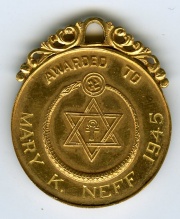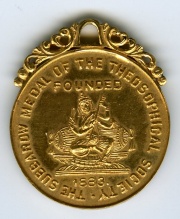Subba Row Medal: Difference between revisions
No edit summary |
|||
| (10 intermediate revisions by 2 users not shown) | |||
| Line 9: | Line 9: | ||
A fund was established that year to cover the costs of creating a mold and striking the medals. Over the years the medal was no longer awarded for essays, but for major contributions to the body Theosophical literature. The design of the medal shows the Hindu goddess [[Saraswati]] on the reverse side, symbolizing knowledge, arts, and music. | A fund was established that year to cover the costs of creating a mold and striking the medals. Over the years the medal was no longer awarded for essays, but for major contributions to the body Theosophical literature. The design of the medal shows the Hindu goddess [[Saraswati]] on the reverse side, symbolizing knowledge, arts, and music. | ||
In 1891 it was resolved "that the medal be awarded at each Annual Convention to the author of the most valuable contribution of the year to theosophical literature, either by translation into English or by original composition."<ref>"Mr. L. W. Rogers Honored," ''The American Theosophist'' 38.3 (March, 1950), 62.</ref> | |||
== Recipients == | |||
{| class="wikitable" | {| class="wikitable" | ||
|- | |- | ||
| Line 39: | Line 42: | ||
|- | |- | ||
| 1906 | | 1906 | ||
| [[Théophile Pascal]] | | [[Théophile Pascal]]; medal presented at Third Federated European Congress in Paris | ||
|- | |- | ||
| 1909 | | 1909 | ||
| Line 69: | Line 72: | ||
|- | |- | ||
| 1936 | | 1936 | ||
| [[J. | | [[J. Émile Marcault]] | ||
|- | |- | ||
| 1938 | | 1938 | ||
| Line 89: | Line 92: | ||
| [[Bhikku Āryāsaṅga]] | | [[Bhikku Āryāsaṅga]] | ||
|- | |- | ||
| | | 1945 | ||
| [[Mary K. Neff]] | | [[Mary K. Neff]] | ||
|- | |- | ||
| Line 129: | Line 132: | ||
|- | |- | ||
| 1995 | | 1995 | ||
| [[Hugh | | [[Hugh Shearman]] | ||
|- | |- | ||
| | | 2010 | ||
| [[Joy Mills]] | | [[Joy Mills]] | ||
|- | |- | ||
| Line 139: | Line 142: | ||
| 2014 | | 2014 | ||
| [[John Algeo]] | | [[John Algeo]] | ||
| | |- | ||
| 2020 | |||
| [[A. T. Barker]]<ref>Anonymous, "About the Subba Row Medal," ''Theosophy in Australia'' 64 (March, 2000), 20.</ref> | |||
|} | |||
== Additional resources == | |||
* [https://www.theosophy.world/encyclopedia/subba-row-medal Subba Row Medal] in Theosophy World | |||
== Notes == | == Notes == | ||
Latest revision as of 15:07, 13 August 2024
In December 27-29, 1883, during the Convention of the Theosophical Society at Adyar instituted the Subba Row Medal, to be awarded to any Theosophical writer producing the best essay on any of the following subjects:
- Aryan Occult Science and Philosophy
- Buddhist Esoteric Philosophy
- Chaldean Esoteric Science and Philosophy and Zoroastrianism
- Jewish Kabbalah and Esoteric Interpretation of the Christian Religion
A fund was established that year to cover the costs of creating a mold and striking the medals. Over the years the medal was no longer awarded for essays, but for major contributions to the body Theosophical literature. The design of the medal shows the Hindu goddess Saraswati on the reverse side, symbolizing knowledge, arts, and music.
In 1891 it was resolved "that the medal be awarded at each Annual Convention to the author of the most valuable contribution of the year to theosophical literature, either by translation into English or by original composition."[1]
Recipients
Additional resources
- Subba Row Medal in Theosophy World

